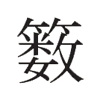

When I’m not sure, I like to refer to Jisho, an online dictionary that has a number of nifty functions. You just have to learn them case by case. Some use kun-readings, not on-readings, to make compounds. Most kanji have at least one on-reading and one kun-reading each, but plenty have no kun-reading and a few have no on-reading. Take Note: There are exceptions to this rule. Adjectives and verbs typically consist of a kanji followed by a hiragana suffix. On-readings are typically used when a kanji forms part of a compound word (usually a noun) kun-readings are normally used for single kanji, either as words in their own right, or as the stems of adjectives or verbs. From the trailhead, this hike is about 4-6 kilometers (I think) over easy terrain.The “kun” reading is used when kanji are used on their own, either as complete nouns in their own right or as adjective and verb stems.

From the Route 308, this hike is about 15-20 kilometers over rolling hills. If you hike from Route 308, this hike rates a Medium. If you hike from the trailhead, this hike rates an Easy. It is a dangerously paved rock path, BE CAREFUL!! The entrance to the trail is just below the toilets. There are surprisingly nice toilets at the trailhead. Yasunobu is a masculine Japanese given name. You can either park in the turn out just beyond the small bridge on Route 308, and walk the 5 kilometers along the dirt road into the trailhead or you can drive them and park at the trailhead itself (its a nice walk, but whether you walk or drive, remember to veer right when you come to the fork in the road, the road sign at this fork has basically fallen into ruins.) There are no romaji signs, but the dirt road is marked with a kanji sign (安の滝). Keep your eyes peeled for a dirt road that tangents off to the left when Route 308 turns to the right and goes over a small bridge. The road becomes narrow and parts of the pavement have washed away due to the flood last year. You can get advice from the people at Yuppara Onsen (on your right as you go through Ani Matagi, about a minute by car beyond Ani Matagi (阿仁マタギ) train station.įrom that Ani Matagi (Utto), continue straight. It is said that your love will be requited if you visit the falls, making this a popular destination for young men and women.įrom Ani, go south on Route 105. Since that time, these falls have been known as "Yasu's Falls" (安の滝 Yasu no Taki). Wrought with despair, Yasu threw herself from the top of the falls. Later, Yasu heard that Kyutaro had been arrested on charges of violating mountain law, and was advised to forget about him. Yasu waited for Kyutaro who never showed. That friend, fearing reprimand by his colleagues, never gave the message to Yasu. Kyutaro, before returning to his village, told his friend to deliver a message to Yasu that he would go to her at a later date. However their love was prohibited by the laws of the mountain. In the early 1700s (during the Tokugawa Period) a young lady named "Yasu" (ヤス) fell in love with a man named "Kyutaro" (久太郎) who worked in the gold mines on Mt Moriyoshi. On clear days, rainbows can be seen coming from the falls in the afternoon. Yasu-no-Taki Falls was chosen as as one of the "100 Waterfalls of Japan" (日本の滝百選 Nihon no Taki Hyakusen, external link). In between levels is the basin of the first waterfall which is a wide space than can be hiked to easily.

The falls are separated into two levels: the main drop of 60 meters on the upper level, and a smaller drop of 30 meters on the lower level.


 0 kommentar(er)
0 kommentar(er)
